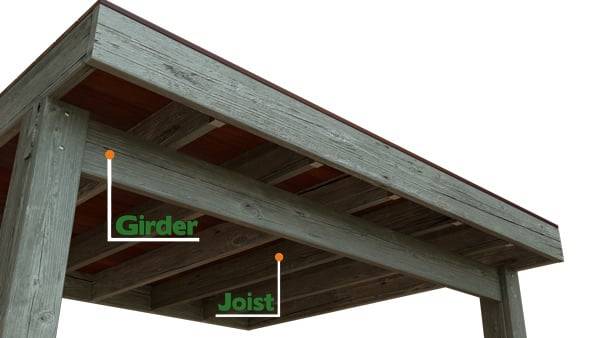
Girders and joists are an integral part of your deck. They work in harmony to support the entire walking area. Because these connections are so important, you need to inspect that they were both properly installed, and properly fastened.
We always advice you to check your local building codes to use as a guideline when checking your deck.
Whether you own one of the 40 million decks that are 10 years or older, or have a brand new one, always exercise caution when inspecting your deck and rely on your common sense to stay safe. If, for any reason, you believe that certain areas might not be safe, do not stand on it or attempt to inspect it. Instead, hire a licensed inspector to check our deck.
What to Look for When Inspecting the Girders on a Deck
The girders are the transitional boards that connect the joists to the posts. Girders need to rest directly on top of the posts with a bracket fastener, or in a notch made in the post. There should never be any girders attached to a post solely with bolts. If you find any connection like this, replace them with the appropriate bracket. Also, pay close attention to the connection areas, if there seems to be any rust present or if the connection is coming loose, replace and/or tighten the fastener. The girder itself must be inspected around the connections for rot. Use a screw driver, or some other sharp object, to pierce the wood. If the wood feels spongy or if the probe sinks into it, the wood is rotted and must be replaced immediately.
What to Look for When Inspecting the Joists
Joists complete the support system of your decking material and must be fastened correctly to avoid any deck failures. When inspecting your joists, make sure they are attached using joist hangers. Also make sure they are on center with the girder. However, if the joist rests on top of the girder, make sure there is a hurricane tie to reduce movement. The hangers and hurricane ties must have hanger nails in every hole. Look out for rust, or any sign of material deterioration, since it can lead to a failure of the joist hanger or rot the wood itself.
What to Look for When Inspecting the Ledger Board
Finally, the most crucial area of your deck is the ledger board. This is the most common place for a deck failure to occur. A ledger board is a piece of wood that is attached to your home and acts as a support beam. Check if your ledger board has proper bolt connections to the house. If all you notice are nails, install bolts according to your local building code. To prevent the ledger board from rotting due to exposure to moisture, flashing must be present. If there is no visible flashing, inspect the area because water may have penetrated and rotted parts of the ledger board or the floor girders of your home. Always look for any rust or corrosion on the connections and flashing since it can damage the wood and potentially cause a deck collapse.
Don’t Forget to Check For…
Check for any areas that can retain water or are susceptible to water runoff, especially around posts. Water accumulation can lead to mold growth which begins rotting wood. Find ways to channel this water to an area outside of the deck grounds. An annual inspection, and routine maintenance, can add years to your deck.
Read more tips on deck safety and inspection. Also, if you have any tips or stories to share of your own, please leave us a comment below. Thanks for reading!